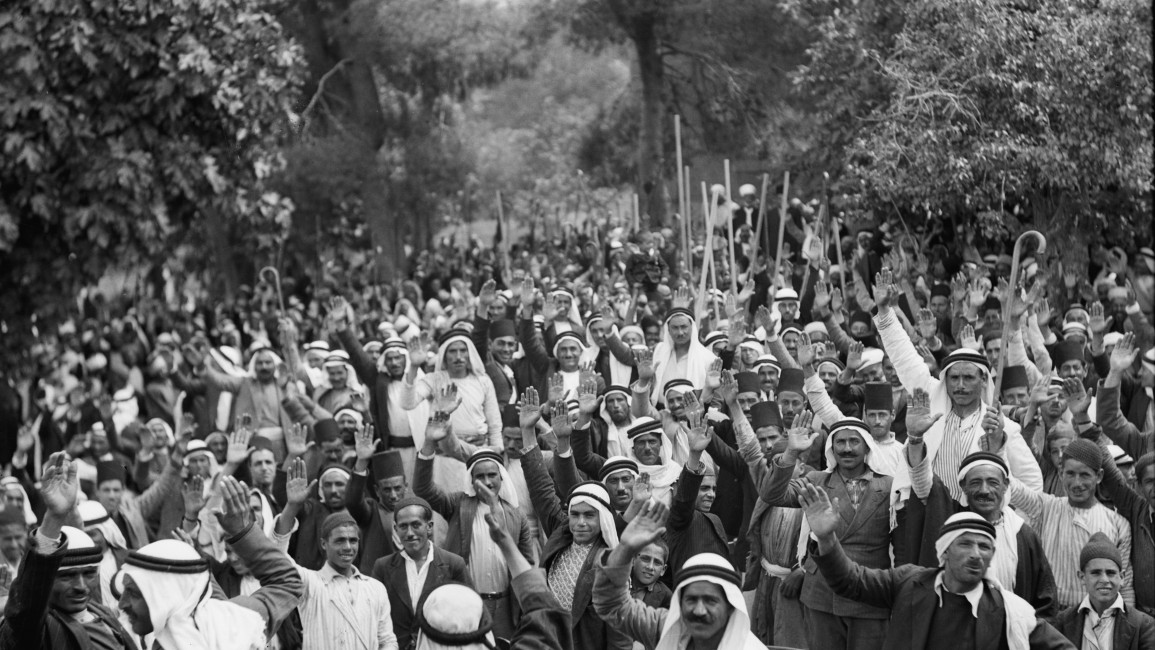
Palestine's 1936 Great Revolt revisited
87 years ago, Palestinians started the first intense and prolonged episode of their anti-colonial mobilisation. The so-called 1936 Great Revolt, which lasted till 1939, bore the promise of changing the trajectory of history but was weighed down by British brutality, Zionist conspiracies, and internal fragmentation.
Today, the Revolt is almost absent from the people’s immediate collective memory, somewhat eclipsed by the 1948 Nakba and other major events thereafter. However, to understand the scale of the Palestinian struggle against Zionism today, it is critical to start the story 87 years prior.
The unprecedented influx of 62,000 European Jews into Palestine in 1935, most fleeing Nazism in central Europe, was perhaps the last straw for Palestinians who for decades resisted the British-facilitated emigration and smuggling of Jewish settlers into their country.
Tensions were running high and both Palestinians and European Jews engaged in a series of violent confrontations that eventually developed into rioting on April 19, 1936 in Jaffa and the Jewish colony of Tel Aviv.
"The so-called 1936 Great Revolt, which lasted till 1939, bore the promise of changing the trajectory of history but was weighed down by British brutality, Zionist conspiracies, and internal fragmentation"
Within two weeks, the protests evolved into a nationwide strike, led by the Arab Higher Committee (AHC), then the central political organ of Palestinians. People commenced a campaign of civil disobedience, shut down their shops, and refused to pay taxes to the British authorities.
Palestinian demands were clear: control the influx of European Jews into Palestine; ban the passing on and selling of land to Jewish settlers; end the British mandate; and grant Palestinians independence like other colonies across the British Empire. The alternative was the obliteration of Palestinian peoplehood, history, culture, and identity.
Palestinians at the time were becoming increasingly aware that Zionism was simply a turn-of-the-century colonialism born out of British colonial rule. The only difference was that it did not yet have a metropole, but was on the mission to create one as a permanent ‘safe haven’ for the world’s Jews.
As such - by sheer delusion or Machiavellian ideology, or both - Zionism marketed itself as an anti-colonial movement, even against the very womb it came out of: the British Empire.
Even earlier than the Mandate of Palestine and the Balfour Declaration, British intervention in the Holy Land was laying the foundations for Israel's occupation - with consequences that continue to reverberate today, writes Gabriel Polley⬇ https://t.co/dNGVcbfsm1
— The New Arab (@The_NewArab) April 1, 2023
What also became evident was that establishing a Jewish state in Palestine was meant to rid Europe of its Jewish ‘problem’ - “the Jewish surplus” - at the expense of another inferior colonised collective, the Palestinians.
The final conclusion was that in order for a Jewish state to materialise, the local population were to be displaced and replaced.
With the first settlements in Palestine in the late 19th century, the settlers saw Palestine as terra nullius and its natives, if at all acknowledged, as inferior and lacking independent nationalist consciousness.
The natives’ resistance to the takeover of their land, therefore, was viewed in the same way as European settlers saw Native Americans: unjustified, undeserving, uncivilised, and unqualified.
The Zionist supremacist worldview was legitimised transcendentally via Biblical myths linking Jews to Palestine as people returning home after two millennia of exile.
So, when the people of Palestine mobilised, Zionist leaders immediately dismissed that Palestinians were capable of organising politically, let alone possessing a rooted national movement. They were adamant that the AHC had foisted the strike upon the Arab population through thuggery and intimidation. Ending the strike, Russian-born Zionist leader Chaim Weisman said, was a matter of lining the right Arab pockets.
The British mandate authorities bought into the Zionist worldview that the strike in its entirety, peaceful and violent, was a criminal enterprise. They disagreed, however, that the rebellion was planned out by the AHC leadership. It was a pan-Palestine movement that emerged in villages and urban communities and included Muslims, Druze, and Christians.
Volunteers from neighbouring Arab countries also joined the resistance. By the end of 1938, in addition to civil disobedience, several armed bands composed of nearly 7500 fighters worked against the British army and the Zionist movement.
"When the people of Palestine mobilised, Zionist leaders immediately dismissed that Palestinians were capable of organising politically, let alone possessing a rooted national movement"
By the Autumn of 1939, Britain had massed 30,000 troops in Palestine to repress the revolt. A policy of collective punishment and retribution was unleashed. Villages were bombarded by air, curfews imposed, and homes demolished. Administrative detentions and summary killings were widespread also. These measures would later be inherited by the Jewish state and normalised as Israeli state policies against Palestinians.
To crush the revolt while aiding the Zionist enterprise, the British collaborated with the settler community and formed the Jewish Settlement Police, which by 1939 included 21,000 Jewish members.
They also created a British-led ‘counter-insurgency force’ of Jewish militants named the Special Night Squads, which, alongside Settlement police, terrorised Palestinian villages and guarded oil pipelines. Within the Yishuv (pre-state settler community), arms were secretly imported and weapon factories established to expand the Haganah, the Jewish paramilitary which later became the core of the Israeli army.
What is more, with the Palestinians on strike, the settlers filled the economic gap, especially on decks and in railway services, providing the British troops with necessary logistical support.
Crushing the revolt was also helped by Palestinians’ internal fragmentation, despite being of one mind regarding the Zionist settlers. The rivalry between the leading Palestinian clans, the Husseinis and the Nashashibis, undermined the formation of a unified strategy. The Nashashibis saw the revolt as a threat to their economic and political interests, as opposed to the Husseinis who aligned with the rebels, although sometimes opportunistically.
The fragmentation was also reflected in Palestine’s newspapers that failed to share a coherent vision of liberation or be impartial about the Husseini-Nashashibi disagreements.
The British brutal war against the country’s Palestinian majority left 14-17% of its male adult population dead, injured, imprisoned, or exiled. More than 5000 Palestinians were killed, 15,000 wounded, nearly 6000 imprisoned, 100 executed, and over 2000 homes destroyed.
Having crushed the revolt, the British rendered Palestinians disarmed, leaderless, defenceless, and their demands for liberation unrealised. The Zionists, meanwhile, were aided to evolve into a semi-state entity with a significant military power that, in 1948, far exceeded in equipment and troops whatever was left of Palestinian resistance and Arab armies combined. The ethnic cleansing of Palestinians was inevitable.
"It may be that today’s Palestinian resistance to Zionism is linked to the revolutionary trajectory set by the 1936 Revolt. Yet the Revolt is also a shadow of unlearnt lessons and unchanged circumstances that continue to weigh the struggle down"
It may be that today’s Palestinian resistance to Zionism is linked to the revolutionary trajectory set by the 1936 Revolt. Yet the Revolt is also a shadow of unlearnt lessons and unchanged circumstances that continue to weigh the struggle down.
Palestinians nowadays are well recognised globally, better equipped, and more organised than any time before. But the fragmentation and disunity amongst actions almost mirror the image of the Husseini-Nashashibi rivalry during the Revolt. The failure to form a unified strategy 87 years ago is a problem that continues to burden the struggle.
As in 1936, Western powers, certainly Britain, still support the Israeli state, despite some lip service to Palestinian rights. And, between then and now, Palestinian reliance on Arab official assistance has proved unreliable, conditional, and occasionally, counterproductive.
Dr Emad Moussa is a Palestinian-British researcher and writer specialising in the political psychology of intergroup and conflict dynamics, focusing on MENA with a special interest in Israel/Palestine. He has a background in human rights and journalism, and is currently a frequent contributor to multiple academic and media outlets, in addition to being a consultant for a US-based think tank.
Follow him on Twitter: @emadmoussa
Have questions or comments? Email us at: editorial-english@newarab.com
Opinions expressed in this article remain those of the author and do not necessarily represent those of The New Arab, its editorial board or staff.



